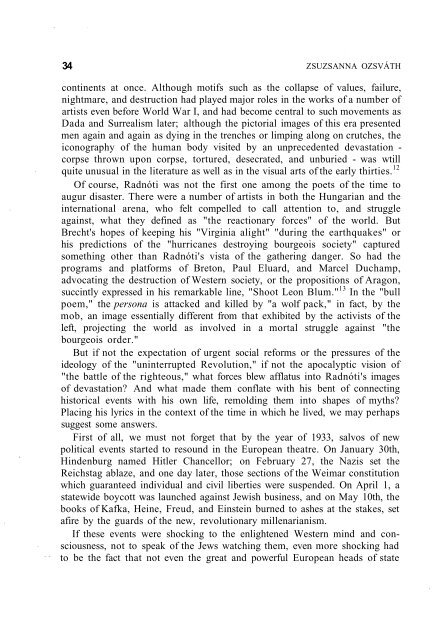HUNGARIAN STUDIES 11. No. 1. Nemzetközi Magyar ... - EPA
HUNGARIAN STUDIES 11. No. 1. Nemzetközi Magyar ... - EPA
HUNGARIAN STUDIES 11. No. 1. Nemzetközi Magyar ... - EPA
- No tags were found...
You also want an ePaper? Increase the reach of your titles
YUMPU automatically turns print PDFs into web optimized ePapers that Google loves.
34 ZSUZSANNA OZSVÁTHcontinents at once. Although motifs such as the collapse of values, failure,nightmare, and destruction had played major roles in the works of a number ofartists even before World War I, and had become central to such movements asDada and Surrealism later; although the pictorial images of this era presentedmen again and again as dying in the trenches or limping along on crutches, theiconography of the human body visited by an unprecedented devastation -corpse thrown upon corpse, tortured, desecrated, and unburied - was wtillquite unusual in the literature as well as in the visual arts of the early thirties. 12Of course, Radnóti was not the first one among the poets of the time toaugur disaster. There were a number of artists in both the Hungarian and theinternational arena, who felt compelled to call attention to, and struggleagainst, what they defined as "the reactionary forces" of the world. ButBrecht's hopes of keeping his "Virginia alight" "during the earthquakes" orhis predictions of the "hurricanes destroying bourgeois society" capturedsomething other than Radnóti's vista of the gathering danger. So had theprograms and platforms of Breton, Paul Eluard, and Marcel Duchamp,advocating the destruction of Western society, or the propositions of Aragon,succintly expressed in his remarkable line, "Shoot Leon Blum." 13 In the "bullpoem," the persona is attacked and killed by "a wolf pack," in fact, by themob, an image essentially different from that exhibited by the activists of theleft, projecting the world as involved in a mortal struggle against "thebourgeois order."But if not the expectation of urgent social reforms or the pressures of theideology of the "uninterrupted Revolution," if not the apocalyptic vision of"the battle of the righteous," what forces blew afflatus into Radnóti's imagesof devastation? And what made them conflate with his bent of connectinghistorical events with his own life, remolding them into shapes of myths?Placing his lyrics in the context of the time in which he lived, we may perhapssuggest some answers.First of all, we must not forget that by the year of 1933, salvos of newpolitical events started to resound in the European theatre. On January 30th,Hindenburg named Hitler Chancellor; on February 27, the Nazis set theReichstag ablaze, and one day later, those sections of the Weimar constitutionwhich guaranteed individual and civil liberties were suspended. On April 1, astatewide boycott was launched against Jewish business, and on May 10th, thebooks of Kafka, Heine, Freud, and Einstein burned to ashes at the stakes, setafire by the guards of the new, revolutionary millenarianism.If these events were shocking to the enlightened Western mind and consciousness,not to speak of the Jews watching them, even more shocking hadto be the fact that not even the great and powerful European heads of state
















